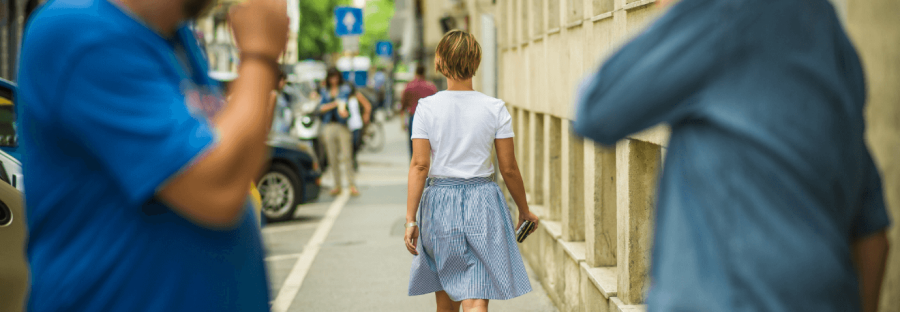What is street harassment?
- NQ reporter Lydia, explains what is meant by street harassment
Street Harassment is unwanted behaviour of a sexual nature, in the form of verbal, physical or psychological harm, done in public spaces. According to the Equality Act 2010, harassment is defined as something in which:
- Violates your dignity
- Makes you feel scared, degraded or humiliated
- Creates an intimidating or offensive environment
Stop Street Harassment UK 2015 defined it as – “Gender-based street harassment is unwanted comments, gestures, and actions forced on a stranger in a public place without their consent and is directed at them because of their actual or perceived sex, gender, gender expression, or sexual orientation.”
Street harassment can include:
- Catcalling
- Wolf whistling
- Stalking
- Invasion of personal space
- Honking
- Leering
- Unwanted sexual comments
- Vulgar gestures
- Flashing
- Public masturbation
- Touching / groping
- Sexual assault
- Rape
Street harassment is often dismissed and not taken seriously, as we are told from a young age that it’s just a part of growing up, and that this sort of behaviour is to be expected. Most women and some men will face gender-based street harassment by strangers at least once in their life. It is a form of gender violence and it’s a human rights violation. Most people first encounter street harassment as a young teenager, waiting at a bus stop in their school uniform, being honked at or catcalled.
It is wrong no matter the situation or the place, it should not be ‘normalised’, as a part of growing up.
Statistics we gathered through a survey conducted for market research, shows that many people have gone out of their way in their daily lives to avoid street harassment. This is not something we should be condoning. The impact of street harassment can lead to limiting a person’s ability to be in public, especially as a woman, therefore being a human rights issue.
Research highlights the extent of the issue, with 64% of people saying that they cross the road from someone, as a way to avoid being harassed. Behavior that limits access to public spaces was most common.
At least monthly women: Pretended to be on the phone – 44% Taken a long route home 34% Avoided empty tube / train carriages – 23% Stopped going out at night alone – 19% Changed what they’re wearing 8%.
It is important to educate ourselves on what is considered as street harassment and what to do in this type of situation.
Sarah Green, Acting Director at the End Violence Against Women Coalition said:
“Sexual harassment is an everyday experience which women and girls learn to deal with, but it’s time to hold a mirror up to it and challenge it. We did this survey to find out about the scale of sexual harassment and the impact it has on the way women live. If women are planning their lives around not being harassed or assaulted, they are not free. Women should be free to live their lives without the threat of harassment and violence, not having to plan and limit their choices to make sure they’re safe.”
People are also victim to harassment based on their race, nationality, religion, disability and class. Harassers often abuse those of minority, in order to feel powerful and in control, it is often a display of social discrimination – sexism, homophobia, classism, racism and so forth. Harassment is never okay, and everyone deserves to be treated with respect, dignity and empathy.
ITS NOT JUST WOMEN.
It’s important to realise that street harassment is not always aimed at women, men can also be affected too, it is just more common for a woman. Members of the LGBQT community are often victims of this hateful crime.
Discrimination still plays a big role in the LGBQT community, and the fear of harassment and assault in public is faced by many, especially transgender individuals. This is a subject that is rarely reported on, with such a small body of information about the impact of street harassment on community.
A study from 2013, stated that out of 93,000 LGBQT individuals in the EU, two-thirds said they would avoid holding hands in public, and due to high levels of street harassment half of them sometimes avoided public spaces in fear, in such locations like restaurants, public transport, streets, car parks and parks.


